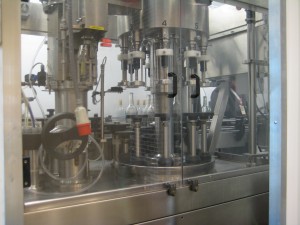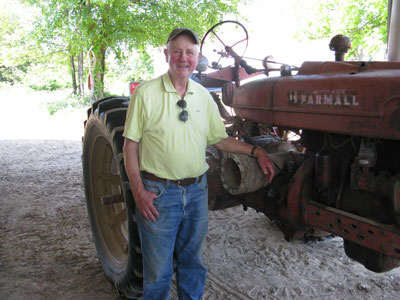Midwest Wine Conference: Missouri’s First Mobile Bottling Trailer
Editor’s note: The author, Danny Wood, is an Australian who recently moved to the Kansas City from Spain via San Francisco. Apart from being a wine lover, he’s a former BBC News reporter and a history documentary maker. This story first appeared in Danny’s new blog, “Regional Wine Taster.”
In the foyer of the Midwest Grape & Wine Conference, to the right of the registration desk, there was a large, white vehicle that looked to me like an ambulance. It was ready for action with its back door open and I could see a man inside, who I assumed was a medic, probably checking heart monitors and other instruments. I know health care in this country is expensive and problematic so I thought to myself, ‘This is great! At least this conference is concerned about peoples’ health — they even have an ambulance standing by in case people get a bit too excited about the free bar.” I realized my mistaken assumption a bit later when Danene Beedle from Missouri Wines told me that the vehicle I’d seen in the foyer was in fact a brand new, mobile bottling trailer belonging to Old Woolam Custom Bottling — the first bottling operation of its kind in Missouri.
Brent Baker, the man inside the vehicle, turned out to be the head bottler (rather than a medic). He said their service is for wineries that don’t have their own bottling machinery. ‘We can run about 1200 bottles an hour and that is filling, corking, capsuling and labeling. So we have empty bottles after the rinse go into the machine, they get filled and when they come out they’re complete and ready to sell.” Brent says their operation can save winery owners a lot of time. ‘When you’ve got to bottle, you can spend a full day doing 150 to 200 cases by hand, when we can do about 600 in a day”, he says, ‘and so they can focus more on perfecting the craft of making wine, going out and doing sales and marketing and self-distribution.”
Brent’s business is a Missouri first, but he said mobile bottling is widespread across Europe, Australia, New Zealand and also California, where there are about 100 mobile bottlers and many of the wineries, even the larger ones, prefer this method to either having their own machinery or sending their grape juice away to be bottled. ‘Mobile bottling is very big in California, Washington, Oregon and becoming very big in Virginia, New York and Texas”, he says. ‘It’s becoming a really big thing because the cost factor of buying a fully automated bottling line is cost prohibitive and, in a lot of cases, you may only run it two weeks out of the year. They can be anything from $50,000 to several hundred thousand to install.” It’s also quicker than sending the grape juice away to be bottled and ensures it gets into bottles as quickly as possible. ‘It’s very high quality, the fill height is perfect, the cork depth is perfect every time, the label, it just makes a really professional product,” adds Brent.
The mobile bottling machine can even do screw caps, although Brent estimates screw cap bottles still only cap about 20% of wine bottles in the USA. As you probably know, in Australia and New Zealand screw caps, even for quality wine, are very popular and my Australian dad — who’s a big wine drinker — is a big fan of them. There’s interesting further reading on the history of the screw cap and the pros and cons versus the cork and other bottle-sealing devices here and here.
For anyone who’s had the opportunity, it’s always fun to watch a bottling process in operation: the upright bottles like soldiers clunking along, the corks being squashed in, the conveyor belts going this way and that. In a BBC News report about how climate change is effecting Spain’s wines (which I made during my former life as a Madrid correspondent), at the end of the video there are some neat shots of the bottling operation in Penedes, Catalonia, of Miguel Torres, one of the world’s biggest winemakers. Of course, there are big bottling plants like the Torres winery and then there are much smaller mobile operations like Brent’s. Comparing the two and their difference in size and flexibility reminded me of the US Army compared to the Navy Seals, or perhaps a real train compared to a model train. That’s what it felt like anyway, when I contemplated the much bigger, factory style bottling operations as I stood inside Brent’s high tech, shiny, mobile bottling trailer.
Brent has long been connected with the art of putting alcoholic beverages into bottles. He used to own a brewery and for the last decade has worked at a number of wineries, helping them with their bottling processes, often by hand. Brent can remember being taken to Stone Hill Winery as a kid, where his parents’ friends, Jim and Betty Held, were renovating the buildings and reviving what is now one of Missouri’s most respected wineries. It could help explain why he’s a patriot for Missouri wines. ‘There’s always been good wine in Missouri,” he says. ‘The thing about the Missouri wine industry is that sometimes it gets poo pooed by California and other states, but we’ve got some very good varietals in Missouri and a lot of really good winemakers who are trying different things — even pumpkin wines. Kansas is growing, Iowa’s growing, Illinois is growing, Arkansas, Oklahoma, Kentucky. It’s pretty amazing what we’re doing here in Middle America.” And Brent’s mobile bottling trailer is ready to help things along.
Reprinted with permission of “Regional Wine Taster” at http://regionalwinetaster.wordpress.com The version of this story in Regional Wine Taster contains a video of the bottling trailer in operation.
[wp_geo_map]





